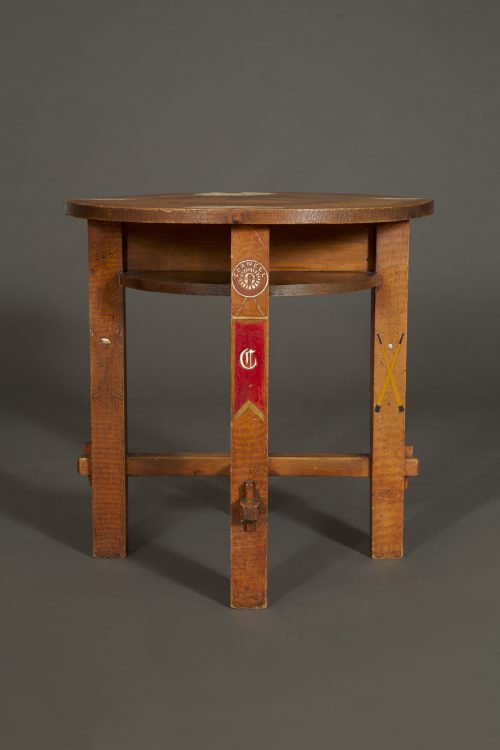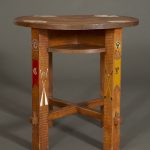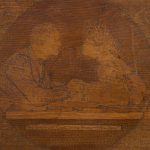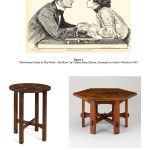11271 AN INTERESTING PYROGRAPHIC POLYCHROME TEXTURED WHITE PINE CIRCULAR GAMES TABLE DECORATED WITH SYMBOLS OF PRINCETON, YALE, HARVARD AND CORNELL UNIVERSITIES American. Early Twentieth Century. Measurements: Height: 30″ (76.2 cm) Diameter: 30 1/4″ (76.8 cm)

Research
Of white pine. The circular top centered by a pyrograph scene of two lovers with caption beneath “The Greatest Game In The World – His Move.” The outer border with four faux painted and engraved hands of cards. The top supported by four square legs united by a tenoned stretcher all decorated with symbols of games and the universities Princeton, Yale, Harvard and Cornell.
The images decorating this interesting games table are drawn using pyrography (or pyrogravure), the process of creating a design with a heated metal implement or a fine flame. The top features an image by the American graphic artist and illustrator Charles Dana Gibson (1867-1944), and depicts a man and woman holding hands gazing romantically at each other over an abandoned game of chess. The caption reads “The Greatest Game In The World – His Move.” This illustration appeared in Collier’s Weekly in 1903 (figure 1) and, as was often seen in Gibson’s work, presents a satirical undertone; the lady’s eyes are already closed in anticipation of a kiss, but the gentleman’s face bears a hesitant and somewhat indifferent expression.
Gibson was best known for creating the “Gibson Girl,” the fashionable ideal of what contemporary writers called the “New Woman” in the late 19th and early 20th centuries, an independent woman of great beauty, fashion, education and comportment. His illustrations were published in Life, Harper’s Weekly and Collier’s magazines.
The gambling and sporting motifs decorating the table may have been intended as further tongue-in-cheek commentary on courtship at the collegiate age. Playing cards, grouped in four hands of poker, are painted around the outside of the table top. Each of the four legs of the table is decorated to the front with banners and crests of four Ivy League universities: Harvard (Massachusetts), Yale (Connecticut), Cornell (New York), and Princeton (New Jersey). The sides of the legs depict sporting equipment associated with the schools’ athletic programs of field hockey, cricket, rowing, and fencing.
The design of the table itself is in the craftsman style, an American development of English Arts and Crafts movement furniture, particularly related to those pieces developed and popularized by Gustav Stickley (1858-1942) and his brothers in the late 19th and early 20th century. Stickley subscribed to the ideals of William Morris and John Ruskin, who asserted the superiority of simple, well-designed crafts made thoughtfully by hand, over mass-produced goods made in tedium in factory settings. The present piece shares similarities in design and construction with two Stickley tables illustrated in figure 2, a tea table sold at Christie’s New York (15 December 2010, Lot 343) and a library table in the Metropolitan Museum of Art, which, like the present piece uses keyed through tenons anchoring the stretchers to the legs.





Comments are closed.